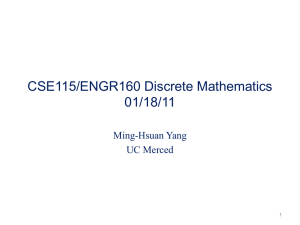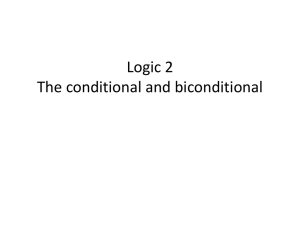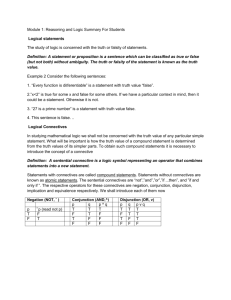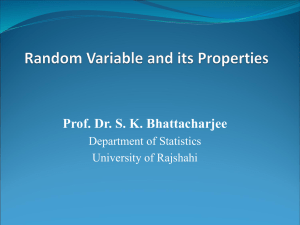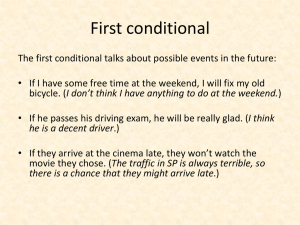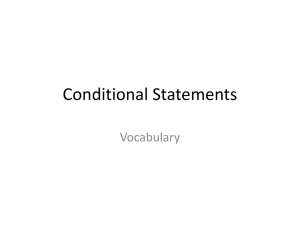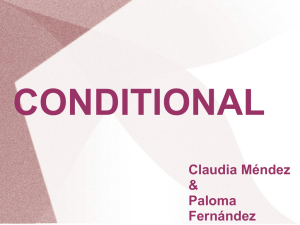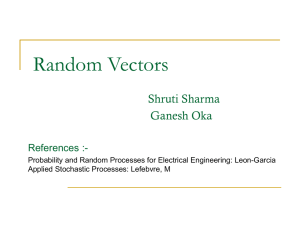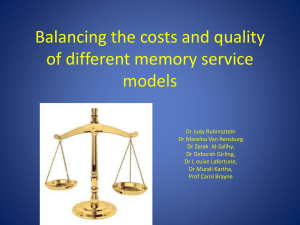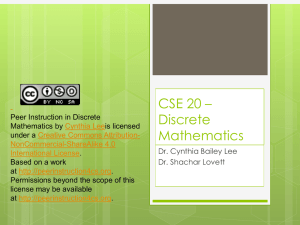CS173: Discrete Math
advertisement
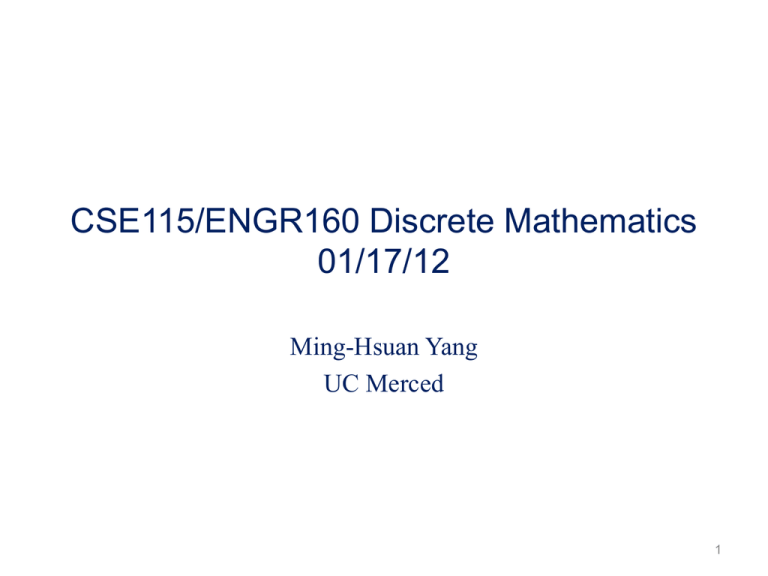
CSE115/ENGR160 Discrete Mathematics 01/17/12 Ming-Hsuan Yang UC Merced 1 CSE 115/ENGR 160 • Instructor: Ming-Hsuan Yang (mhyang@ucmerced.edu) • Teaching assistant: Jime Yang (jyang44@ucmerced.edu) and Chih-Yuan Yang (cyang35@ucmerced.edu) • Lectures: – KL 217, Tuesday/Thursday 4:30 pm to 5:45 pm • Labs: – SE 138, Monday 8:00 am to 10:50 am (CSE115-02L), Wednesday 1:00 pm to 3:50 pm (CSE115-03L) • Web site: http://faculty.ucmerced.edu/mhyang/course/cse115 2 Office hours • Office hours: – Wednesday 3:00 pm – 4:00 pm – SE 258 • TA hours – Monday 8:00 am to 10:50 am, Wednesday 1:00 pm to 3:50 pm – SE 138 3 Course goals • Mathematical reasoning – Logic, inference, proof • Combinatorial analysis – Count and enumerate objects • Discrete structures – Sets, sequences, functions, graphs, trees, relations • Algorithmic reasoning – Specifications and verifications • Applications and modeling – Internet, business, artificial intelligence, etc. 4 Topics • • • • • • • • • Logic Proof Sets Functions Number theory Counting Relations Graph Boolean algebra 5 Textbook • Discrete Mathematics and Its Applications by Kenneth H. Rosen, 7th edition, McGraw Hill 6 Prerequisite • Upper division standing • Basic knowledge of calculus (MATH 21 and MATH 22) • Basic knowledge in computer science 7 Grading • • • • • 5% Class participation 25% Homework 20% Four quizzes 20% Two midterms 30% Final 8 Class policy • Do not use computers or smart phones in class • All the lecture notes will be posted on the class web • Weekly homework assigned on Thursday and due in the following Thursday in class • Must be your own work • Homework returned in class 9 1.1 Propositional logic • Understand and construct correct mathematical arguments • Give precise meaning to mathematical statements • Rules are used to distinguish between valid (true) and invalid arguments • Used in numerous applications: circuit design, programs, verification of correctness of programs, artificial intelligence, etc. 10 Proposition • A declarative sentence that is either true or false, but not both – Washington, D.C., is the capital of USA – California is adjacent to New York – 1+1=2 – 2+2=5 – What time is it? – Read this carefully 11 Logical operators • • • • • • Negation operator Conjunction (and, ^) Disjunction (or v ) Conditional statement Biconditional statement Exclusive Or 12 Negation 13 Example • “Today is Friday” – It is not the case that today is Friday – Today is not Friday • At least 10 inches of rain fell today in Miami – It is not the case that at least 10 inches of rain fell today in Miami – Less than 10 inches of rain fell today in Miami 14 Conjunction Conjunction: p ^ q is true when both p and q are true. False otherwise 15 Example • p: “Today is Friday”, q: “It is raining today” • p˄q “Today is Friday and it is raining today” – true: on rainy Fridays – false otherwise: • Any day that is not a Friday • Fridays when it does not rain 16 Disjunction Disjunction: p v q is false when both p and q are false. True otherwise 17 Example • p ˅ q: “Today is Friday or it is raining today” – True: • • • Today is Friday It is raining today It is a rainy Friday – False • Today is not Friday and it does not rain 18 Exclusive or Exclusive Or is true when exactly one of p, q is true. False otherwise 19 Conditional statement Conditional Statement: • p is called the premise (or antecedent) and q is called the conclusion (or consequent) • p q is false when p is true and q is false. True otherwise 20 Conditional statement pq • Also called an implication if p, then q p implies q if p, q p only if q p is sufficient for q a sufficient condition for q is p q if p q whenever p q when p q is necessary for p a necessary condition for p is q q unless ┐ p q follows from p Conditional Statement: pq is false when p is true and q is false. True otherwise Example p: you go, q: I go. pq means “If you go, then I go” is equivalent to p only if q “You go only if I go” (not the same as 21 “I go only if you go” which is q only if p) pq • p only if q: – p cannot be true when q is not true – The statement is false if p is true but q is false – When p is false, q may be either true or false – Not to use “q only if p” to express pq • q unless ┐ p – If ┐ p is false, then q must be true – The statement is false when p is true but q is false, but the statement is true otherwise 22 Example • If Maria learns discrete mathematics, then she will find a good job – Maria will find a good job when she learns discrete mathematics (q when p) – For Maria to get a good job, it is sufficient for her to learn discrete mathematics (sufficient condition for q is p) – Maria will find a good job unless she does not learn discrete mathematics (q unless not p) 23 Common mistake for pq • Correct: p only if q • Mistake to think “q only if p” 24 Example • “If today is Friday, then 2+3=6” – The statement is true every day except Friday even though 2+3=6 is false 25 Converse, contrapositive and inverse • For conditional statement p q – Converse: q p – Contrapositive: ┐q ┐ p – Inverse: ┐p ┐ q • Contrapositive and conditional statements are equivalent 26 Biconditional statement • Biconditional Statement: “p if and only if q” • p q is true when p, q have the same truth value. False otherwise • Also known as bi-implications 27 Example • P: “you can take the flight”, q: “you buy a ticket” • P q: “You can take the flight if and only if you buy a ticket” – This statement is true • If you buy a ticket and take the flight • If you do not buy a ticket and you cannot take the flight 28 Truth table of compound propositions 29 Precedence of logic operators 30 Bit operations 31 1.2 Translating English to logical expressions Why? English is often ambiguous and translating sentences into compound propositions removes the ambiguity Using logical expressions, we can analyze them and determine their truth values We can use rules of inferences to reason about them 32 Example “ You can access the internet from campus only if you are a computer science major or you are not a freshman. p : “You can access the internet from campus” q : “You are a computer science major” r : “You are freshmen” p ( q v ┐r ) 33 System specification • Translating sentences in natural language into logical expressions is an essential part of specifying both hardware and software systems. • Consistency of system specification. • Example: Express the specification “The automated reply cannot be sent when the file system is full” 34 Example 1. Let p denote “The automated reply can be sent” 2. Let q denote “The file system is full” The logical expression for the sentence “The automated reply cannot be sent when the file system is full” is 35 Example Determine whether these system specifications are consistent: 1. The diagnostic message is stored in the buffer or it is retransmitted. 2. The diagnostic message is not stored in the buffer. 3. If the diagnostic message is stored in the buffer, then it is retransmitted. 36 Example • Let p denote “The diagnostic message is stored in the buffer” • Let q denote “The diagnostic message is retransmitted” The three specifications are 37 Example • If we add one more requirement “The diagnostic message is not retransmitted” The new specifications now are This is inconsistent! No truth values of p and q will make all the above statements true 38 Logic gates 39
